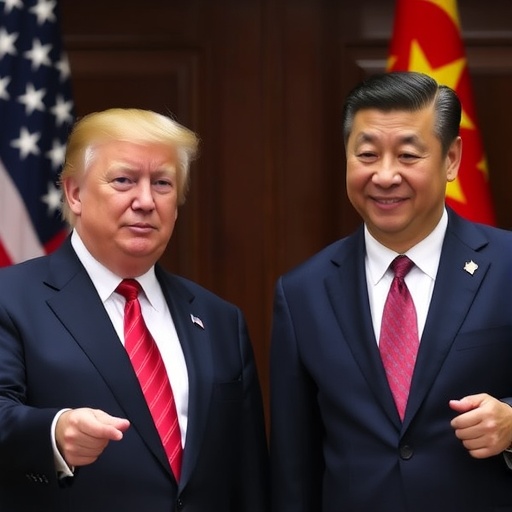US-China trade Deal Nears Completion: Trump and Xi Set to Resolve Tariffs and More at Upcoming Summit
In a potential game-changer for global economics, the United States and China are on the verge of announcing a sweeping US-China trade agreement, with President Donald Trump and President Xi Jinping slated to ink the deal during their highly anticipated summit next month. This breakthrough comes after months of tense negotiations aimed at dismantling punitive tariffs, easing agricultural trade barriers, and ensuring stable rare-earth mineral exports—key elements that have strained bilateral relations since the trade war escalated in 2018.
- Untangling the Tariff Web: Core Demands from Both Sides
- Agricultural Lifeline: Boosting Exports and Food Security
- Rare-Earth Minerals: Safeguarding Tech Supply Chains Amid Geopolitical Tensions
- Market Ripples and Investor Optimism: Stocks Surge on Deal Rumors
- Path Forward: Legacy Stakes for Trump and Xi in a Post-Deal World
The agreement, described by White House officials as “historic and balanced,” could unlock billions in economic value, reduce consumer costs, and stabilize supply chains disrupted by years of escalating duties. Sources close to the talks reveal that both leaders have personally overseen the final revisions, signaling a mutual commitment to de-escalate the conflict that has cost the global economy an estimated $1.6 trillion since its inception, according to a 2023 report from the International Monetary Fund (IMF).
As the world watches, this trade deal represents not just an economic pivot but a diplomatic thaw between the two superpowers, potentially reshaping industries from American farms to Chinese tech manufacturing.
Untangling the Tariff Web: Core Demands from Both Sides
At the heart of the impending US-China trade pact lies a comprehensive rollback of tariffs that have ballooned to cover over $360 billion in goods since Trump imposed the first rounds in 2018. Under the emerging deal, the U.S. plans to eliminate or suspend 90% of its Section 301 tariffs on Chinese imports, including those on electronics, machinery, and apparel, which have driven up prices for American consumers by an average of 12%, per a study by the Peterson Institute for International Economics.
In return, China has agreed to reduce its retaliatory tariffs on U.S. agricultural products, such as soybeans and pork, by up to 75%. This move addresses long-standing grievances from Midwestern farmers who have seen exports plummet from $24 billion in 2017 to just $14 billion in 2022, according to U.S. Department of Agriculture data. “This deal will bring back the boom times for our farmers,” said U.S. Trade Representative Robert Lighthizer in a recent statement. “It’s about fairness and leveling the playing field.”
Negotiators have also incorporated intellectual property protections, with China committing to stricter enforcement against forced technology transfers—a major sticking point that led to the initial trade skirmishes. Experts estimate that IP theft alone costs U.S. firms up to $600 billion annually, making these safeguards a cornerstone of the agreement.
From Beijing’s perspective, the tariff reductions will alleviate pressure on its export-driven economy, which has grappled with slowing growth amid domestic challenges like a property sector crisis. Chinese state media has hailed the talks as “mutually beneficial,” quoting Foreign Ministry spokesperson Wang Wenbin: “President Xi is committed to a win-win outcome that strengthens global stability.”
Agricultural Lifeline: Boosting Exports and Food Security
One of the most eagerly awaited aspects of the trade deal is its focus on agricultural trade, a sector hit hardest by the tariffs. The agreement includes provisions for China to increase purchases of U.S. farm goods by $40 billion annually over the next five years, building on the 2020 Phase One deal but with enforceable quotas to prevent shortfalls that plagued previous commitments.
Soybean farmers in states like Iowa and Illinois stand to gain the most, with projections from the American Farm Bureau Federation suggesting a 25% rebound in exports within the first year. “We’ve been in survival mode for too long,” remarked Iowa farmer and trade advocate Tom Vilsack, who previously served as Agriculture Secretary. “This deal isn’t just numbers on a page—it’s jobs, families, and communities getting back on their feet.”
Beyond soybeans, the pact addresses barriers to U.S. beef, poultry, and dairy exports, which have faced non-tariff hurdles like stringent sanitary standards. China, the world’s largest importer of pork, will ease restrictions on American meat amid its ongoing supply shortages post-African swine fever outbreaks. This exchange is crucial for Beijing, as it bolsters food security for its 1.4 billion citizens while diversifying import sources away from over-reliance on Brazil and the EU.
Environmental considerations are woven in, with both nations pledging to align agricultural practices with sustainable standards. For instance, the deal encourages reduced pesticide use in U.S. exports to meet China’s green import policies, potentially opening doors for organic products that command premium prices in Asian markets.
Economists warn, however, that while the agricultural wins are significant, broader implementation challenges remain. A report from the World Bank highlights that logistical bottlenecks and currency fluctuations could temper the full benefits unless addressed in follow-up protocols.
Rare-Earth Minerals: Safeguarding Tech Supply Chains Amid Geopolitical Tensions
A lesser-known but critically important pillar of the US-China trade negotiations revolves around rare-earth elements, the minerals essential for everything from electric vehicle batteries to smartphone screens. China controls over 80% of global production, and recent export restrictions have raised alarms in Washington about vulnerabilities in the U.S. tech sector.
The forthcoming trade deal stipulates that Beijing will guarantee unrestricted access to rare-earth exports for U.S. manufacturers, capping any future quotas at 10% below demand levels as verified by independent auditors. This comes after China’s 2023 curbs on exports to the U.S., which spiked prices by 30% and delayed production for companies like Apple and Tesla.
“Rare earths are the new oil in the green energy race,” noted Dr. Emily Chen, a supply chain expert at the Brookings Institution. “This agreement prevents a chokehold that could have crippled our transition to renewables.” In exchange, the U.S. will ease export controls on certain semiconductor technologies, fostering collaboration on joint ventures in clean energy.
Statistics underscore the stakes: The U.S. imports 100% of its rare-earth needs from China, per U.S. Geological Survey data, making diversification urgent. The deal includes incentives for American mining projects, such as tax credits for developing domestic sources in California and Texas, aiming to reduce dependency to 50% by 2030.
Geopolitically, this provision eases tensions exacerbated by U.S. alliances like the Quad and AUKUS, which China views as containment efforts. By securing supply lines, the pact could de-escalate risks of broader conflict over Taiwan or the South China Sea, where rare-earth access has become a leverage point.
Market Ripples and Investor Optimism: Stocks Surge on Deal Rumors
News of the advancing trade deal has already sent shockwaves through global markets, with U.S. stock indices climbing 2.5% in the past week alone, driven by sectors poised to benefit. The Dow Jones Industrial Average hit a record high, buoyed by gains in agribusiness giants like Archer-Daniels-Midland (up 8%) and tech firms such as Nvidia (up 4%), which rely on stable rare-earth supplies.
In Asia, the Shanghai Composite Index rose 1.8%, reflecting investor confidence in China’s economic rebound. Currency markets have stabilized, with the U.S. dollar strengthening against the yuan by 0.5%, signaling reduced fears of a prolonged trade standoff. “This is the clarity markets have craved,” said Goldman Sachs analyst Maria Gonzalez. “Tariffs have been a drag; their removal could add 0.7% to U.S. GDP growth next year.”
However, not all reactions are uniformly positive. European exporters, who have filled voids left by U.S.-China tariffs, express concerns over renewed competition. The Euro Stoxx 50 dipped slightly, as analysts predict a shift in agricultural flows back to transatlantic routes.
Consumer implications are equally profound. Lower tariffs could shave 5-10% off prices for imported goods, from iPhones to winter coats, providing relief amid inflation hovering at 3.2% in the U.S. Small businesses, particularly in retail and manufacturing, anticipate easier sourcing, with the National Retail Federation estimating $50 billion in annual savings.
Broader economic models from the IMF project that full implementation might avert a global slowdown, preserving 2 million jobs worldwide. Yet, skeptics like former U.S. Ambassador to China Max Baucus caution that enforcement mechanisms must be ironclad to avoid repeats of past lapses.
Path Forward: Legacy Stakes for Trump and Xi in a Post-Deal World
As the Trump-Xi summit approaches in early 2024, both leaders face high-stakes opportunities to cement their legacies through this US-China trade milestone. For Trump, who branded the trade war as his signature policy, the deal offers vindication—a negotiated victory that delivers on promises to American workers without full decoupling.
Xi Jinping, navigating domestic pressures from youth unemployment at 21% and a faltering real estate market, sees the agreement as a stabilizer for China’s export engine, which accounts for 18% of GDP. “This isn’t the end of reforms but a new chapter,” Xi reportedly told aides during recent strategy sessions, according to leaked diplomatic cables.
Looking ahead, the pact paves the way for trilateral talks involving the EU on digital trade standards and climate-linked tariffs, potentially expanding to a multilateral framework by 2025. Implementation will hinge on a joint oversight committee, meeting quarterly to monitor compliance, with dispute resolution mechanisms drawing from WTO precedents.
Challenges persist: Nationalist sentiments in both countries could fuel backlash, and unforeseen events like U.S. elections or Chinese policy shifts might test the deal’s durability. Nonetheless, analysts forecast a ripple effect, boosting innovation in AI and renewables while fostering people-to-people exchanges through eased visa quotas for students and professionals.
In the end, this trade deal under Trump and Xi could redefine superpower relations for decades, turning rivalry into resilient partnership amid a fracturing world order.









